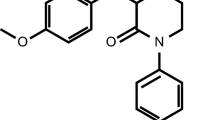Summary
A complex series of cellular and molecular interactions is involved in fibrinolysis, which is controlled by mechanisms that provide for localised activation or suppression without systemic effects, thereby providing an orderly process of haemostasis, healing and response to thrombotic injury. Excessive or deficient fibrinolysis may be congenital or acquired, the latter including iatrogenic interventions, and such variations in the balance may result in accelerated recovery from disease or a thrombotic or haemorrhagic complication.
Similar content being viewed by others
References
Al-Mondhiry HAB, Bilezikian SB, Nossel HL. Fibrinogen ‘New York’ — an abnormal fibrinogen associated with thromboembolism: functional evaluation. Blood 45: 607–619, 1975
Aoki N, Harpel PC. Inhibitors of the fibrinolytic enzyme system. Seminars in Thrombosis and Hemostasis 10: 24–41, 1984
Aoki N, Moroi, Sakata Y, Yoshida N, Matsuda M. Abnormal plasminogen: a hereditary molecular abnormality found in a patient with recurrent thrombosis. Journal of Clinical Investigation 61: 1186–1195, 1978
Aoki N, Saito H, Kamiya T, Koie K, Sakata Y, et al. Congenital deficiency of α2-plasmin inhibitor associated with severe hemorrhagic tendency. Journal of Clinical Investigation 63: 877–884, 1979
Banyai L, Varadi A, Patthy L. Common evolutionary origin of the fibrin-binding structures of fibronectin and tissue-type plasminogen activator. FEBS Letters 163: 37–41, 1983
Collen D. On the regulation and control of fibrinolysis. Thrombosis and Haemostasis 43: 77–89, 1980
Fletcher AP, Alkjaersig NK. The hematologic consequences of thrombolytic therapy. Progress in Hematology 14: 183, 1986
Francis CW, Marder VJ. Physiologic regulation and pathologic disorders of fibrinolysis. In Colman et al. (Eds) Hemostasis and Thrombosis. Basic Principles and Clinical Practice, J. B. Lippincott Company, Philadelphia, in press
GISSI: Gruppo Italiano per lo Studio Delia Streptochinasi Nell’infarto Miocardico. Effectiveness of intravenous thrombolytic treatment in acute myocardial infarction. Lancet 1: 397–401, 1986
Kassell NF, Tomer JC, Adams Jr HP. Antifibrinolytic therapy in the acute period following aneurysmal subarachnoid hemorrhage: preliminary observations from the cooperative aneurysm study. Journal of Neurosurgery 61: 225–230, 1984
Marder VJ. The use of thrombolytic agents. Choice of patient, drug administration, laboratory monitoring. Annals of Internal Medicine 90: 802–808, 1979
Marder VJ, Francis CW. Clinical aspects of fibrinolysis. In Williams et al. (Eds) Hematology, p. 1266, p. 1462, McGraw Hill, New York, 1983
Marder VJ, Soulen RL, Atichartakarn V, Budzynski AZ, Parulekar S, et al. Quantitative venographic assessment of deep vein thrombosis in the evaluation of streptokinase and heparin therapy. Journal of Laboratory and Clinical Medicine 89: 1018–1029, 1977
Marder VJ, Rothbard RL, Fitzpatrick PG, Francis CW. Rapid lysis of coronary artery thrombi with anisoylated plasminogen: streptokinase activator complex: treatment by bolus intravenous injection. Annals of Internal Medicine 104: 304–310, 1986
Mullertz S. Plasminogen activator in spontaneously active human blood. Proceedings of the Society for Experimental Biology and Medicine 83: 291, 1953
Pannell R, Gurewich V. Pro-urokinase: a study of its stability in plasma and of a mechanism for its selective fibrinolytic effect. Blood 67: 1215, 1986
Philips M, Juul AG, Thorsen S. Human endothelial cells produce a plasminogen activator inhibitor and a tissue-type plasminogen activator-inhibitor complex. Biochimica et Biophysica Acta 802: 99–110, 1984
Sherry S, Alkjaersig N, Fletcher AP. Fibrinolysis and fibrinolytic activity in man. Physiological Reviews 39: 343, 1959
Smith RAG, Dupe RJ, English PD, Green J. Fibrinolysis with acyl enzymes: a new approach to thrombolytic therapy. Nature 290: 505–508, 1981
Stead NW, Bauer KA, Kinney TR, Lewis JG, Cambell EE, et al. Venous thrombosis in a family with defective release of vascular plasminogen activator and elevated plasma factor VIII/von Willebrand’s factor. American Journal of Medicine 74: 33–39, 1983
TIMI Study Group. The Thrombolysis in Myocardial Infarction (TIMI) trial. Phase 1 findings. New England Journal of Medicine 312: 932–936, 1985
Urokinase Pulmonary Embolism Trial: a national cooperative study. American Heart Association Monograph No. 39. Circulation 47 (Suppl. 2): II–I–II–108, 1973
Verstraete M, Su CAPF, Tanswell P, Feuerer W, Collen D. Pharmacokinetics and effects on fibrinolytic and coagulation parameters of two doses of recombinant tissue-type plasminogen activator in healthy volunteers. Thrombosis and Haemostasis 56: 1–5, 1986.
Author information
Authors and Affiliations
Rights and permissions
About this article
Cite this article
Marder, V.J., Francis, C.W. Physiological Balance of Haemostasis and Bleeding. Drugs 33 (Suppl 3), 13–21 (1987). https://doi.org/10.2165/00003495-198700333-00003
Published:
Issue Date:
DOI: https://doi.org/10.2165/00003495-198700333-00003




